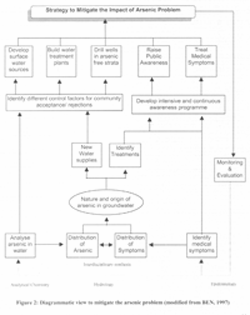The use of alternative safe water options
to mitigate the arsenic problem in Bangladesh: a community perspective
Md. Jakariya. M.Sc. Thesis,
Department of Geography, University of Cambridge, Aug 2000
CHAPTER 3. A STRATEGY TO MITIGATE
THE ARSENIC PROBLEM
Following is a diagrammatic representation of a strategy to
mitigate the impact of arsenic problem of Bangladesh:
Figure 2 : Diagrammatic view to Mitigate the
Arsenic Problem (modified from BEN, 1997) |Click on the figure for a larger
view|

It is to be observed from the above diagram that the whole
arsenic scenario in Bangladesh can be divided into the following major
categories:
This is one of the most important components. Co-ordination
is needed among different stakeholders not only to avoid repetition of
activities but also to find a mitigation package that is acceptable to the
community. Apart from that funding is crucial to run different research
activities related to the problem.
This is also an important component. Until and unless the
exact causes of arsenic contamination in the groundwater are identified it is
very difficult to develop a standard community-acceptable mitigation package.
It is very important to develop a system of arsenic detection
in tube well water that the community can operate themselves; this would minimize
the expenses incurred in testing by outside experts.
Safe drinking water also has to be community-acceptable and
affordable. At the same time it is also important to make available different
types of mitigation options for different type of communities and for different
physiographic conditions. Therefore, the involvement of community in the
selection, implementation, operation and maintenance of a system is crucial.
Drinking arsenic-free water is currently the only way of
preventing the disease. Therefore, it is very important to develop a strong
awareness programme in order to motivate people in the rural communities to
drink water from arsenic-free sources. At the same time, it is very important to
do further research aimed at finding a proper treatment for the disease.
The continuous monitoring of the presence of arsenic in
tube well water is essential: the arsenic level varies seasonally, therefore it
is important to check each tube well at least once every six months. At the same
time monitoring the performance of the provided options is also important. It
will be both cost-effective and convenient if communities are trained to carry
out these activities themselves.
It has been observed from the above discussion that except
for the geological investigation of the causes of arsenic contamination, the
active presence of the community in all other activities is crucial for the
sustainable implementation of the arsenic mitigation activities in the rural
areas of Bangladesh.
Since almost all the provided alternative safe water options
are new both to the experts and the community, proper consultation and ensured
co-operation from the community are pre-requisites for the establishment of a
safe water implementation plan. The importance of identifying different factors
for community participation in the various alternative safe water options can be
observed from the figure. The community needs to consult during different phases
of project implementation, i.e. from the selection of options to the monitoring
and evaluation of a particular option.
One concludes that community forms the core component of the
different activities aimed at mitigating the arsenic problem. The following
section describes the different dynamics of community and community
participation.
|